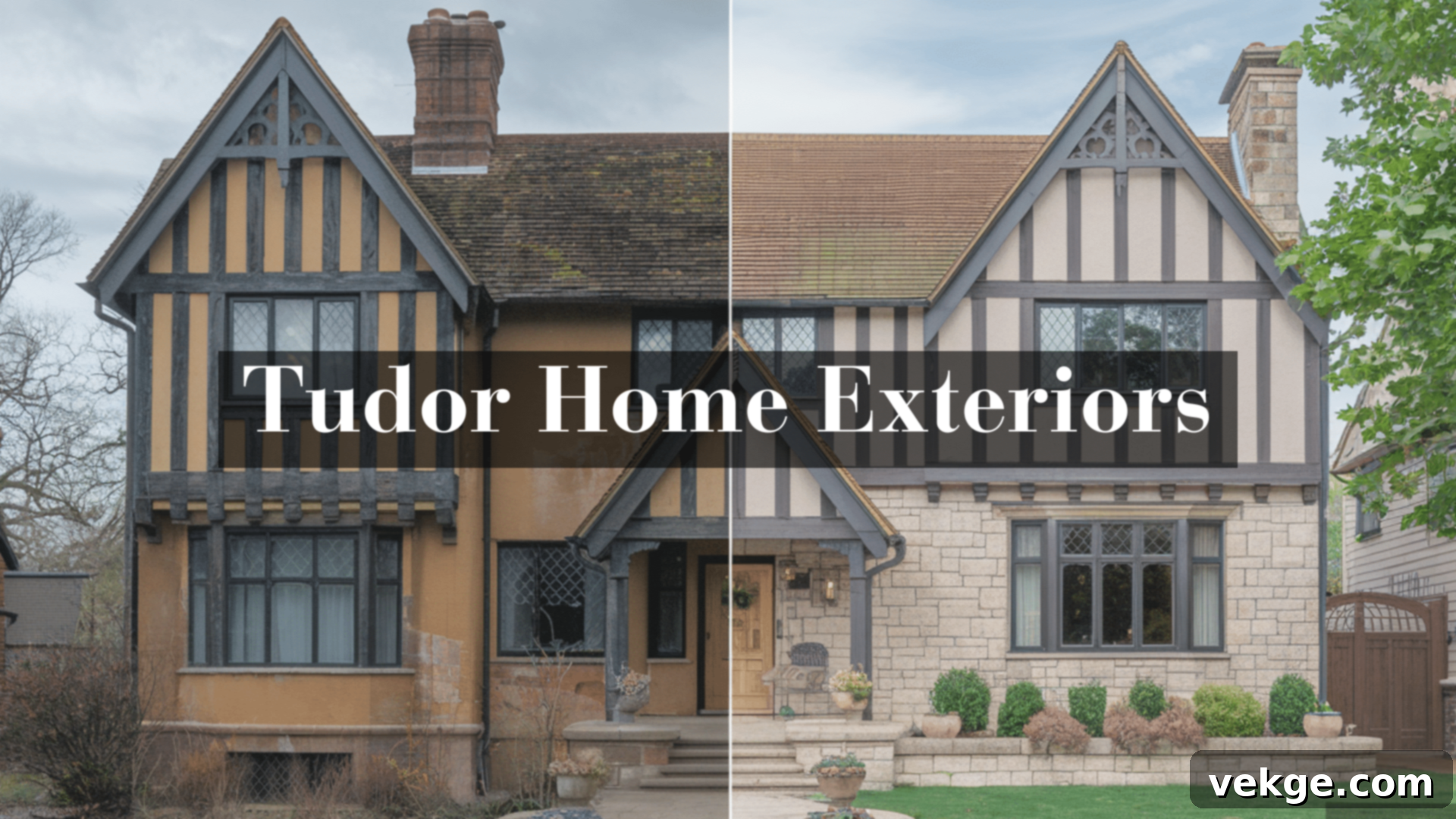Transform Your Tudor Home: Stunning Exterior Makeovers & Renovation Guide
Tudor-style homes captivate with their distinct, storybook features—the striking half-timber frames, steeply pitched roofs, and charming stone or brick details that immediately catch the eye. These homes exude a timeless beauty and unique character, rooted deeply in historical architecture.
While their inherent charm is undeniable, many homeowners often wonder how to refresh the outside look of their Tudor residences without sacrificing their special, historic character. The challenge lies in harmonizing modern updates with the architectural integrity that makes a Tudor home so beloved.
In this comprehensive guide, we’ll dive into real-world transformations, showcasing how thoughtful renovations can breathe new life into these classic structures. I’ve gathered compelling before-and-after examples that illustrate the vast potential for enhancing your Tudor home’s exterior.
These inspiring examples and expert tips are designed to guide you through key renovation areas, helping you:
- Select the perfect color palettes that beautifully complement traditional Tudor elements.
- Skillfully update doorways and windows, ensuring they enhance the home’s style and efficiency.
- Significantly boost your home’s curb appeal, making it a standout on your street.
Let’s explore these remarkable Tudor makeovers and empower you to envision and plan your own home’s stunning new look!
Before and After: Inspiring Tudor Home Exterior Transformations
Having dedicated years to assisting homeowners in refreshing their cherished Tudor homes, I’ve seen firsthand how these updates can enhance beauty while keeping their special character intact. It’s a common misconception that classic homes cannot be modernized without losing their historical charm, but that couldn’t be further from the truth.
Prepare to be inspired as I present a collection of real Tudor homes that have undergone stunning exterior makeovers. Each transformation meticulously maintains its unique Tudor essence, yet emerges looking remarkably fresh, current, and impeccably cared for.
1. Black and White Classic Reinvention

This charming 1930s Tudor home, once looking tired and faded, achieved a striking rejuvenation through a simple yet powerful color update. The owners wisely returned to the iconic black-and-white combination that is synonymous with classic Tudor architecture. By painting the stucco a bright, crisp white and all the exposed trim a deep, rich black, they achieved a dramatic visual impact.
The change, though seemingly basic, profoundly elevated the house’s presence and curb appeal from the street. The bold contrast immediately draws the eye, highlighting the intricate timber details that are the hallmark of Tudor design.
- Clean, crisp white stucco that brightens the facade and eliminates any signs of yellowing or age.
- Sharp, deep black trim that creates a strong visual outline and makes the half-timbering truly stand out.
- Original half-timber details meticulously preserved and accentuated, honoring the home’s historical integrity.
- Fresh, matching garage doors that seamlessly integrate with the new color scheme, providing a cohesive look.
2. Front Door Focus: A Grand Welcome
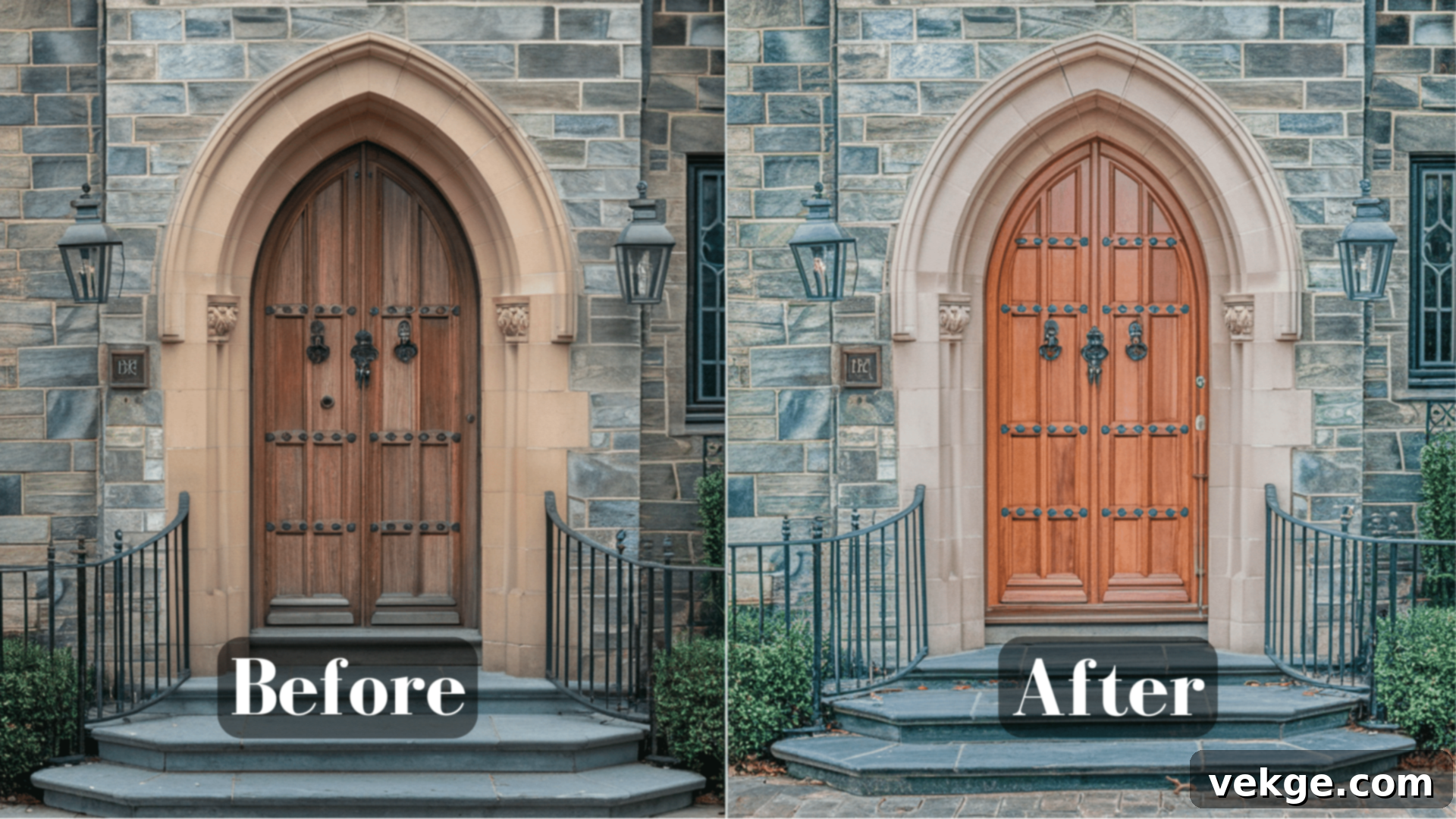
Sometimes, the most significant transformation can originate from focusing on a single, key area. For this Tudor home, the entire makeover gracefully centered around the installation of a new front door, which effortlessly became the captivating star of the home’s exterior. The original, rather plain wooden door was replaced with a magnificent custom arched door crafted from rich walnut.
The choice of an arched top perfectly echoes the traditional Tudor style, while the warm tones of the walnut exude a sense of heritage and quality. Exquisite brass hardware, gleaming in the sun, serves as a natural focal point, drawing the eye directly to the inviting entry. This thoughtful upgrade not only enhances the aesthetic but also creates a much grander and more welcoming entrance.
- An elegantly arched top that beautifully complements and reinforces the classic Tudor architectural style.
- Intricate hand-carved details on the luxurious walnut wood, adding texture, depth, and a bespoke artisan touch.
- Period-correct hardware in polished brass, chosen to reflect historical accuracy and provide a touch of refined elegance.
- A new slate step and a graceful iron railing that complete the entry, providing both safety and enhanced curb appeal.
3. Thoughtfully Updated Windows
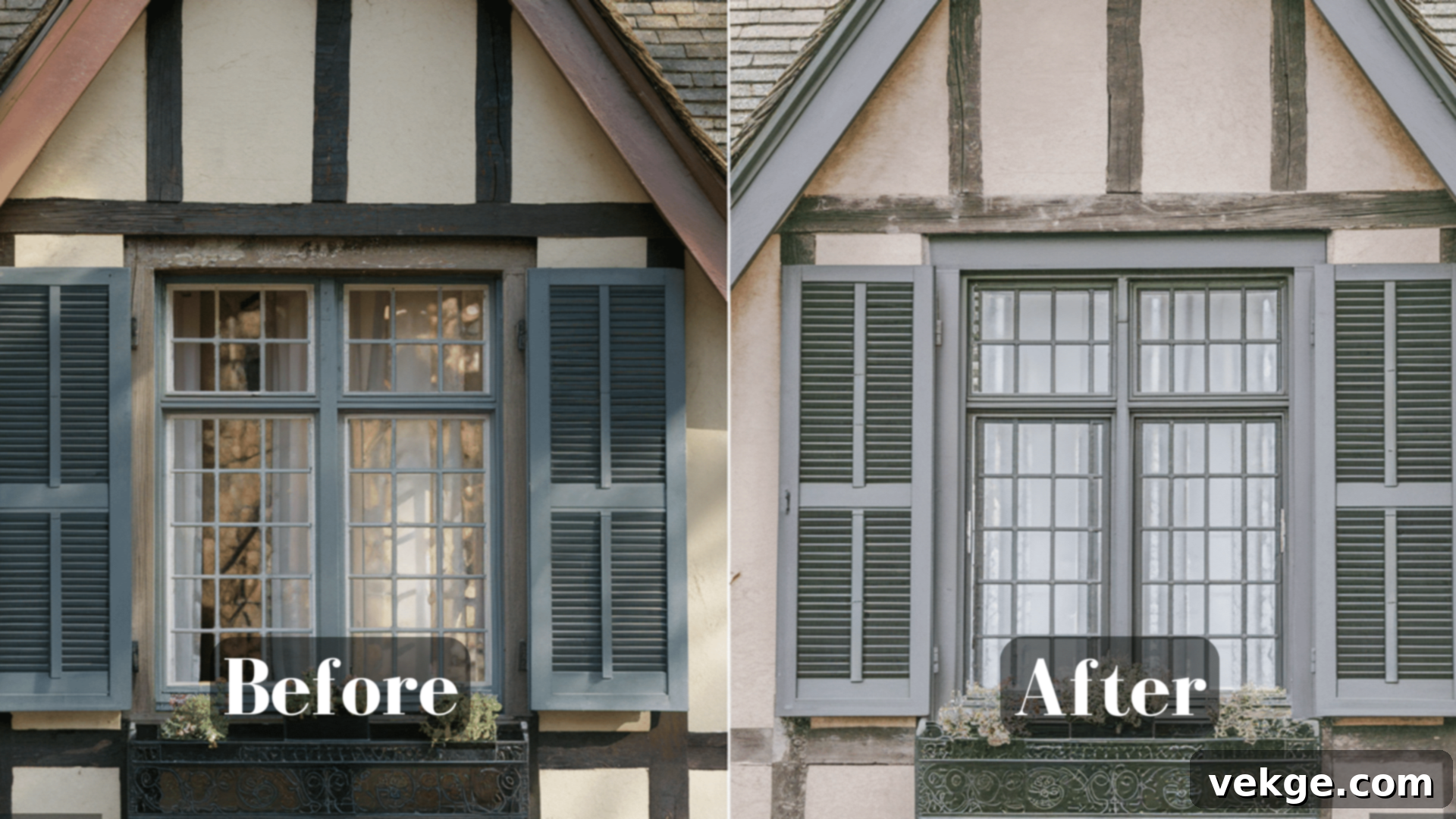
Just as eyes are windows to the soul, your home’s windows are its expressive features. This Tudor received a complete “eye lift” that dramatically improved both its appearance and performance. The old, inefficient single-pane windows were expertly swapped for new, high-efficiency units featuring authentic divided light patterns that meticulously matched the home’s original age and style.
This strategic upgrade delivered dual benefits: significant savings on heating and cooling bills due to improved insulation, and a beautifully refreshed look that honored the home’s intrinsic style. The new windows not only provide superior energy efficiency but also enhance the architectural authenticity, proving that modern functionality can perfectly coexist with historical aesthetics.
- Double-pane efficiency offering superior insulation and energy savings, combined with traditional aesthetic appeal.
- Original window shapes and sizes meticulously preserved, maintaining the home’s authentic architectural proportions.
- Subtle iron window boxes added beneath select windows, introducing a touch of greenery and European charm.
- New coordinating shutters installed on upper windows, providing additional texture and visual interest while aligning with the Tudor character.
4. Stone Facade Restoration

After enduring over 70 years of various weather conditions, the stone base of this Tudor home had naturally darkened and appeared somewhat neglected. Rather than opting for the costly and often less authentic solution of replacement, the owners chose a meticulous restoration. The stone was carefully cleaned and expertly repointed, a process that revived its inherent beauty.
The natural colors of the stone—subtle pinks, variegated grays, and warm tans—which had been obscured by years of dirt, grime, and aging mortar, vividly came back to life. This restoration not only preserved the original material but also showcased the timeless elegance and robust quality of the home’s foundational elements.
- An authentic approach using no fake stone or paint; simply clean, natural stone that reveals its true colors and textures.
- Fresh mortar applied in a complementary shade, not only strengthening the facade but also enhancing the stone’s appearance.
- Subtle landscape lighting strategically added to highlight the exquisite texture and depth of the stone after dusk, creating a warm, inviting glow.
- Small, carefully selected plants tucked between stones, introducing softness and a touch of natural integration without overshadowing the masonry.
5. Harmonious Modern Tudor Blend
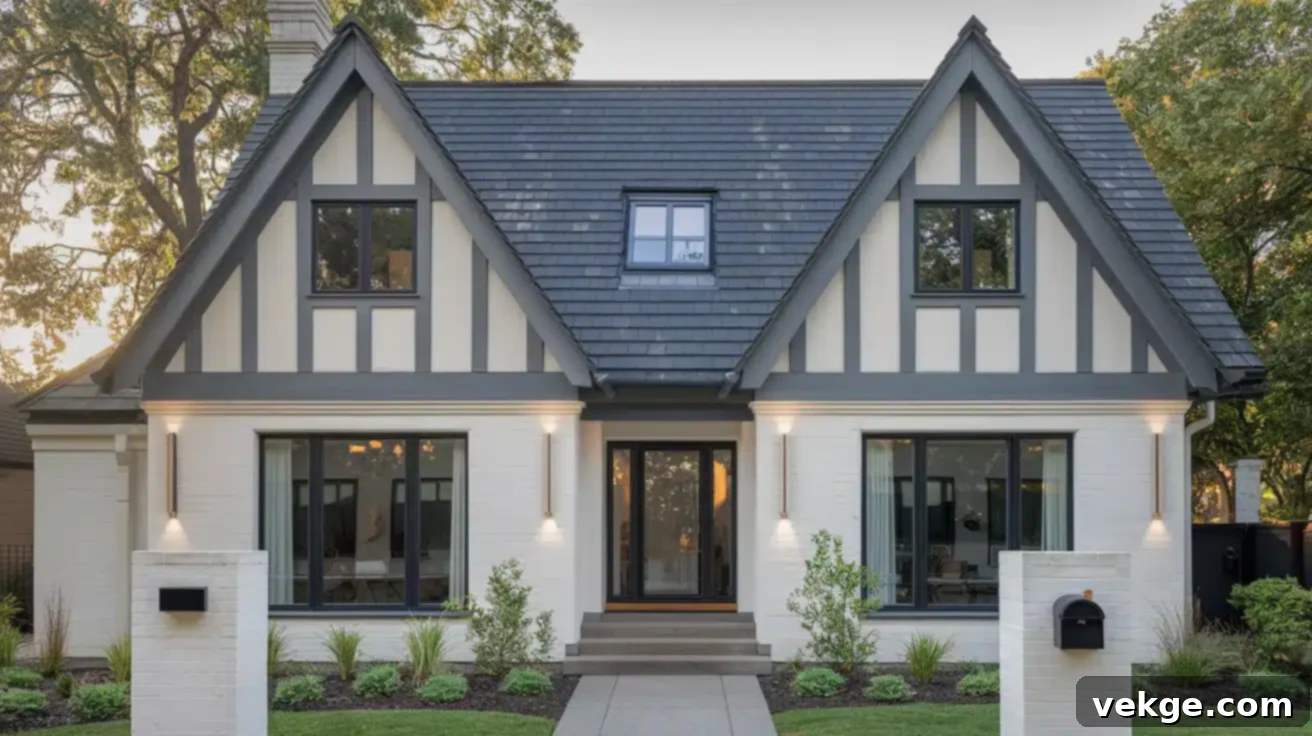
This transformation beautifully demonstrates that it’s entirely possible to respect a home’s historical roots while embracing contemporary living. This renovation meticulously preserved all the classic Tudor lines and architectural elements, but artfully introduced subtle, modern touches that enhance its appeal.
The owners retained the signature steep rooflines and cross gables, which are quintessential Tudor features. However, they opted for a more contemporary color scheme of sophisticated gray and soft white, moving away from the more expected black and cream. This choice provided a fresh, updated aesthetic that still resonated with the home’s historic charm, showcasing a perfect blend of old and new.
- Updated, softer colors that offer a modern sensibility while still deeply respecting the traditional Tudor style.
- Modern light fixtures carefully selected to provide efficient illumination and a clean aesthetic without looking out of place.
- Clean-lined gutters and downspouts that offer modern functionality and contribute to a sleek, uncluttered appearance.
- Simple, elegant modern house numbers and mailbox, adding a final touch of contemporary sophistication.
6. Lush Landscaping Makeover
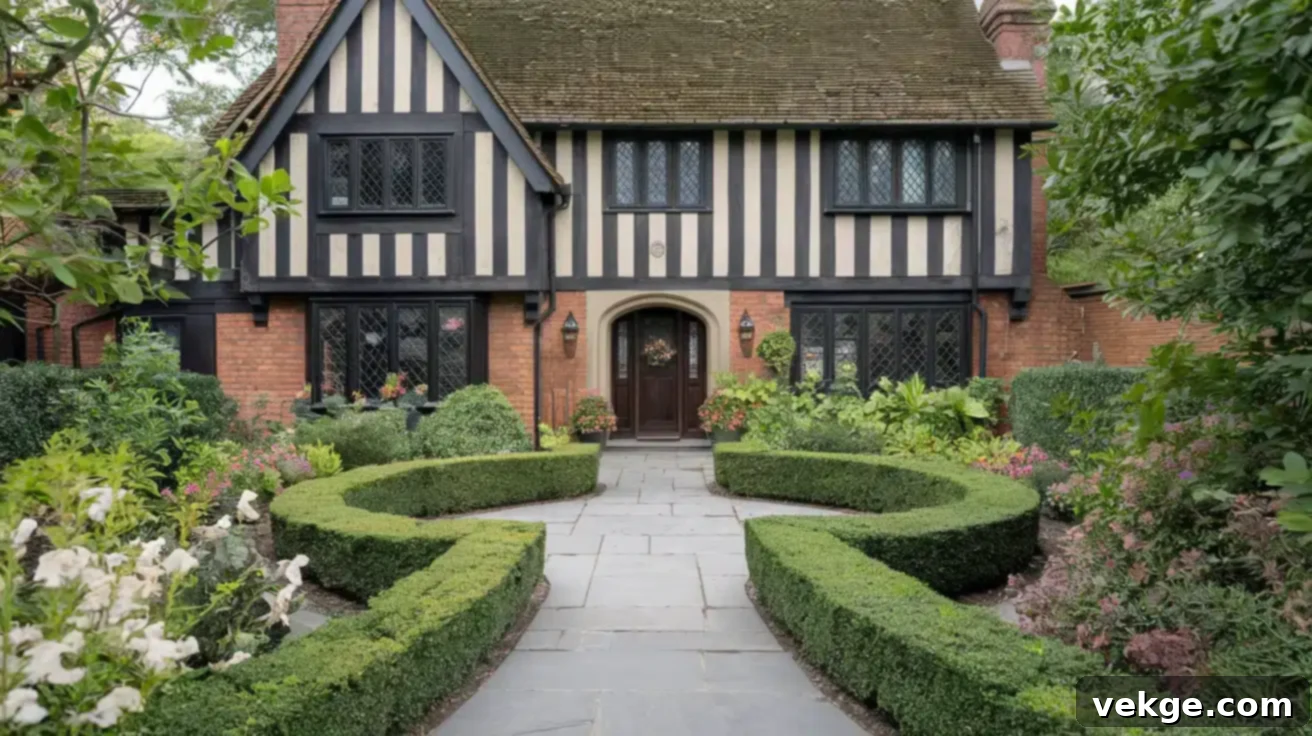
Sometimes, the most profound transformation isn’t about the house itself, but about the thoughtful revitalization of its surroundings. In this case, the owners initiated a dramatic landscaping makeover by removing overgrown, unruly bushes that had long obscured the home’s best architectural features. The result was an immediate unveiling of the Tudor’s inherent beauty.
They introduced a gracefully curved pathway, designed to draw the eye towards the entrance, alongside neatly trimmed low boxwood hedges that provide year-round structure. Carefully chosen flowers, complementing the home’s exterior colors without competing with its intricate details, completed the picture. This intentional landscaping redefined the property’s curb appeal, framing the house elegantly and making it truly shine.
- An open, unobstructed view that now proudly showcases the home’s intricate architectural details, previously hidden.
- Year-round structure and verdant appeal provided by evergreen hedges, ensuring continuous beauty.
- A new, artfully curved path that gently guides the eye and guests directly to the welcoming front door.
- Selection of low-maintenance plants that promise enduring beauty without quickly overgrowing, ensuring sustained neatness.
7. Strategic Roof Replacement
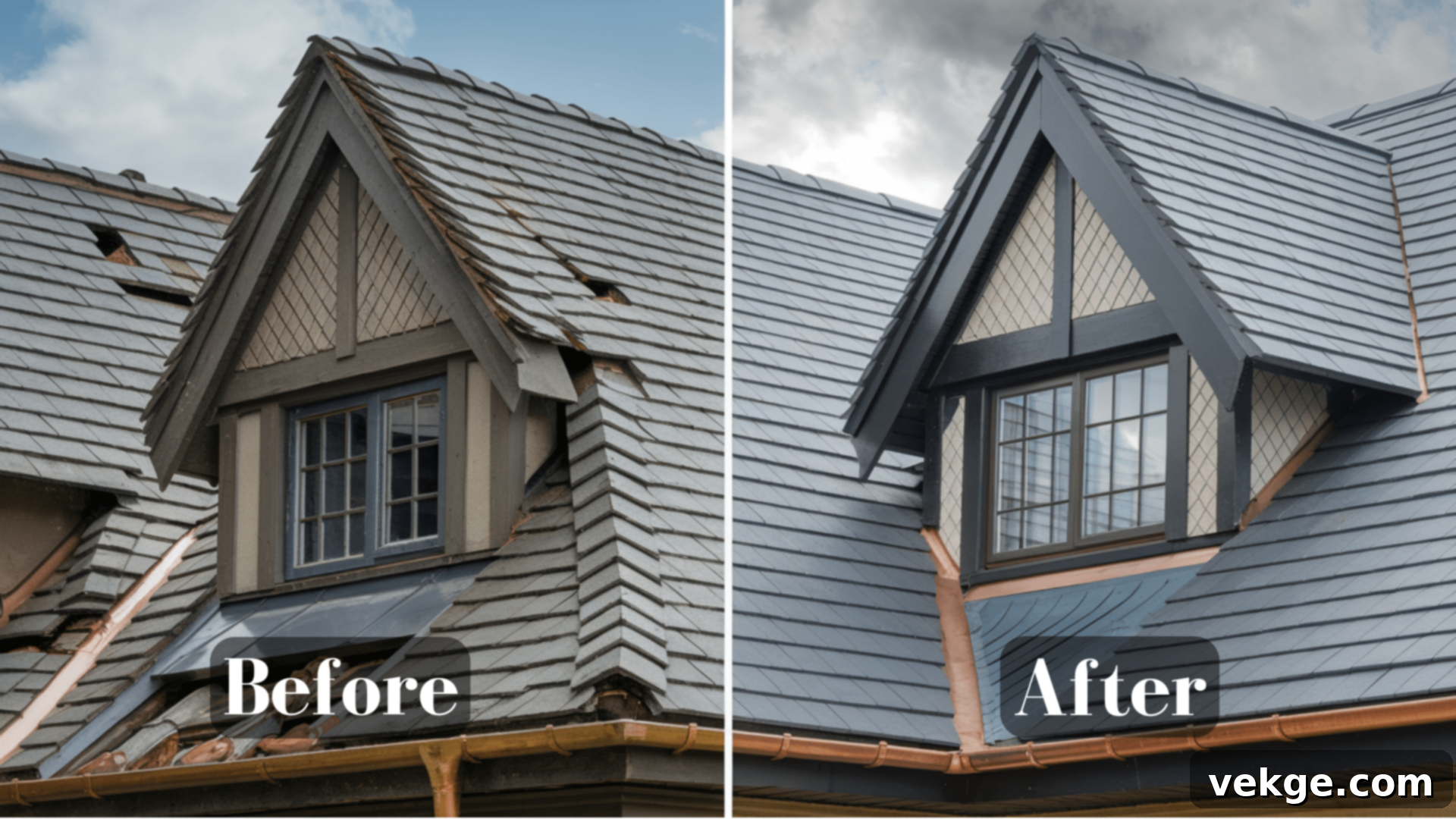
A roof on a Tudor home is far more than mere protection from the elements; it is a major stylistic declaration, crucial to its overall aesthetic. This particular makeover centered on a strategic roof replacement that beautifully mimicked the old-world charm of natural slate but utilized advanced modern materials. The owners selected varying shades of gray and black tiles, laid in an intentionally uneven pattern, to create an authentic, time-worn appearance as if the roof had graced the home for centuries.
This approach combines the timeless beauty of traditional materials with the durability and performance of contemporary technology, ensuring both longevity and a magnificent visual impact. The roof now serves as a crowning glory, perfectly encapsulating the Tudor spirit.
- Long-lasting composite materials offering superior durability, weather resistance, and reduced maintenance compared to traditional slate.
- Varied colors and textures meticulously designed to mimic the natural variations and depth of genuine slate tiles.
- Special attention paid to the intricate roof edges and peaks, ensuring precise craftsmanship that enhances architectural authenticity.
- Elegant copper flashing that will naturally develop a beautiful, protective patina over time, adding character and value.
8. Thoughtful Lighting Enhancement
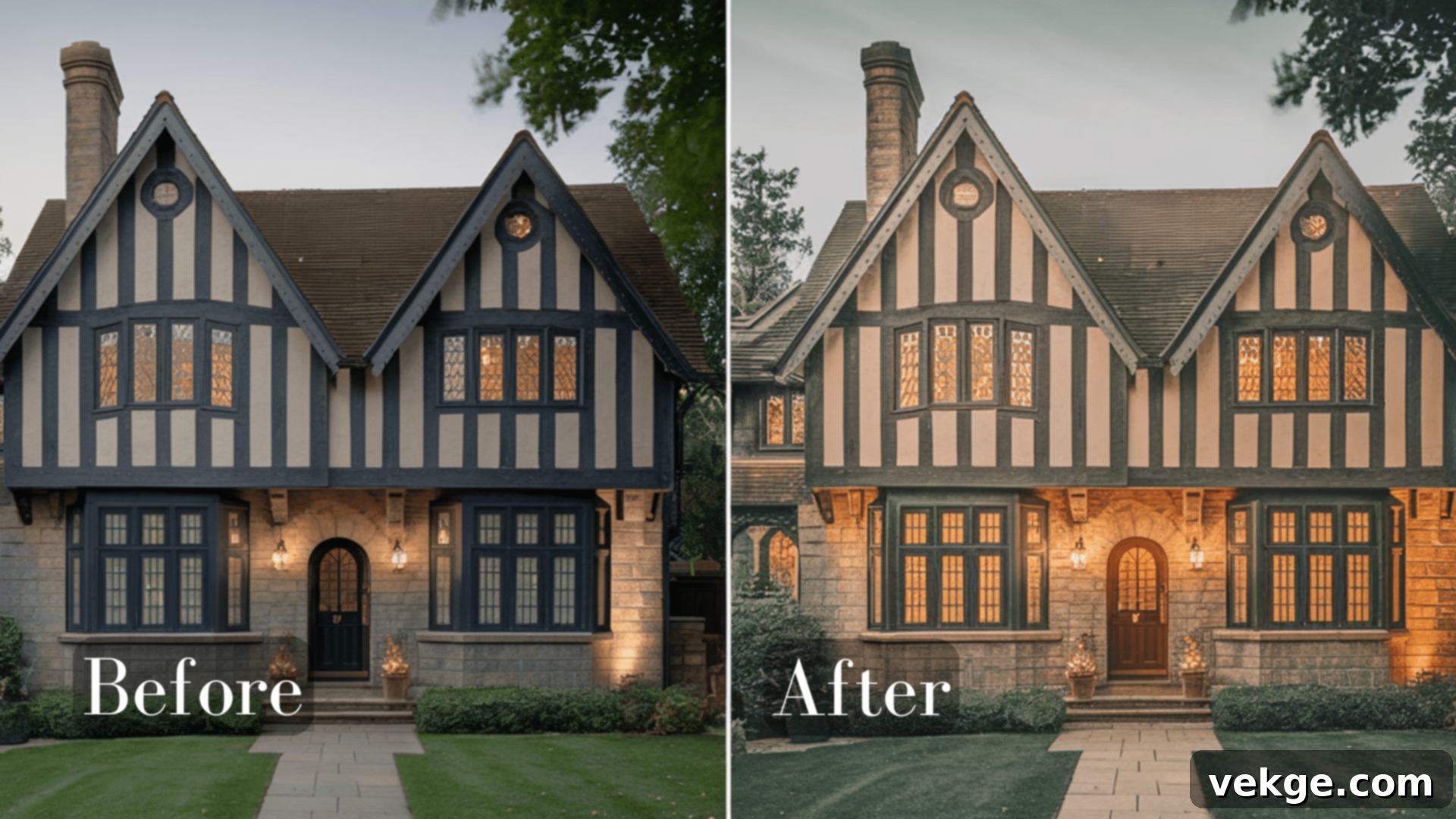
The power of light to transform an environment is undeniable, and this Tudor update beautifully harnessed that power. The focus was on implementing thoughtful lighting solutions to artfully highlight the home’s most distinguished features. New, warm-toned fixtures were strategically placed to cast a gentle, inviting glow on the intricate half-timbering, illuminate pathways for safety, and render the entire home wonderfully welcoming after dark.
Beyond aesthetics, this enhancement also significantly boosts security and functionality, extending the enjoyment of the home’s exterior into the evening hours. The interplay of light and shadow now creates a dynamic and captivating facade.
- Classic copper lanterns, carefully selected to match the historical period and architectural style of the Tudor home.
- Subtle, hidden uplights strategically placed to showcase the texture of the walls and accentuate the dramatic gables.
- Integrated motion sensors for enhanced safety and convenience, ensuring illumination when needed.
- Warm-toned LED bulbs that mimic the soft, inviting glow of traditional candlelight, enhancing ambiance.
9. Sophisticated Color Scheme Update
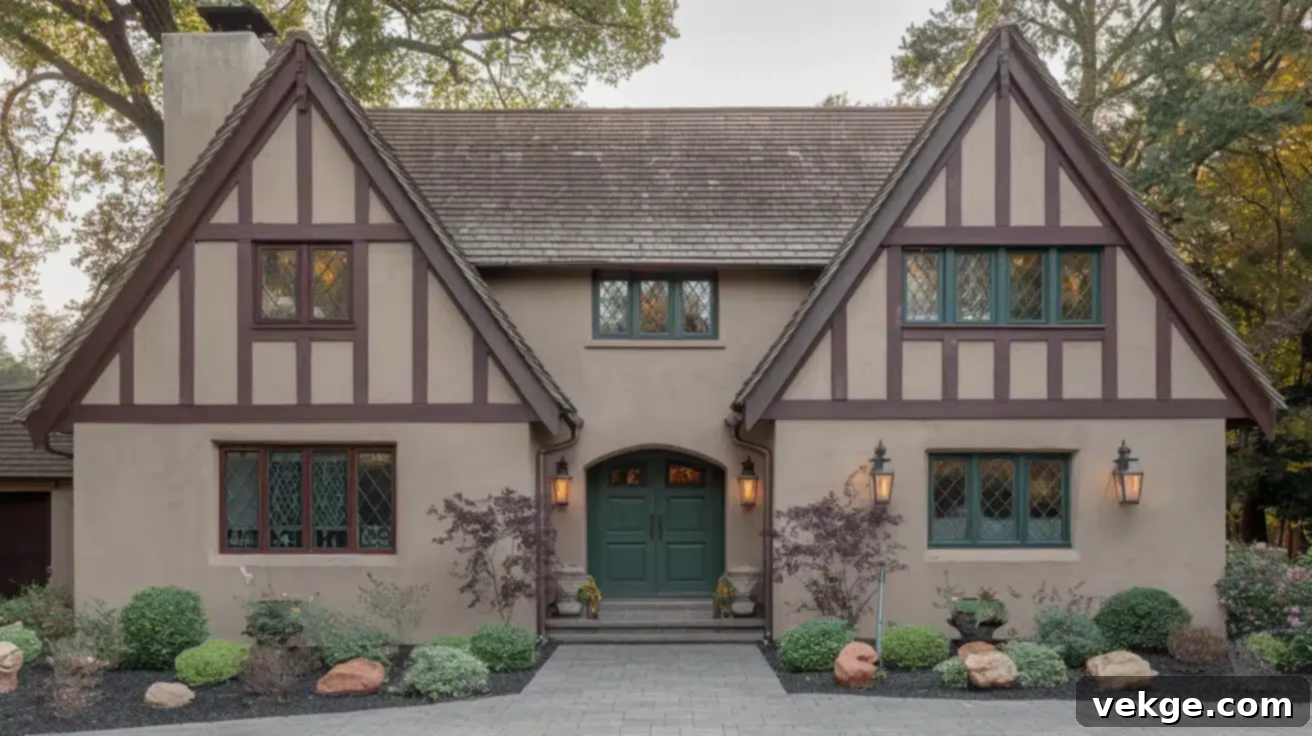
Bold yet meticulously thoughtful color choices were the catalyst for transforming this Tudor home from an easily overlooked residence into a truly head-turning masterpiece. The owners were careful to preserve all the traditional Tudor elements that define its character. However, they opted for a refined and sophisticated color palette.
They selected a rich taupe for the stucco areas, a deep, earthy brown for the prominent timbers, and a forest green for the doors and accent features. This three-color scheme adds incredible depth and interest, creating a cohesive and historically appropriate yet distinctly refreshed aesthetic that stands out beautifully against its natural surroundings.
- Earth tones carefully chosen to harmonize with and complement the surrounding natural landscaping, fostering a sense of organic beauty.
- A sophisticated three-color scheme that provides visual depth, complexity, and undeniable curb appeal.
- All colors meticulously selected from authentic historical Tudor palettes, ensuring an enduring and timeless appeal.
- Crisp white trim strategically applied to brighten and precisely define architectural edges, enhancing the overall clarity of the design.
10. Elegantly Extended Entryway
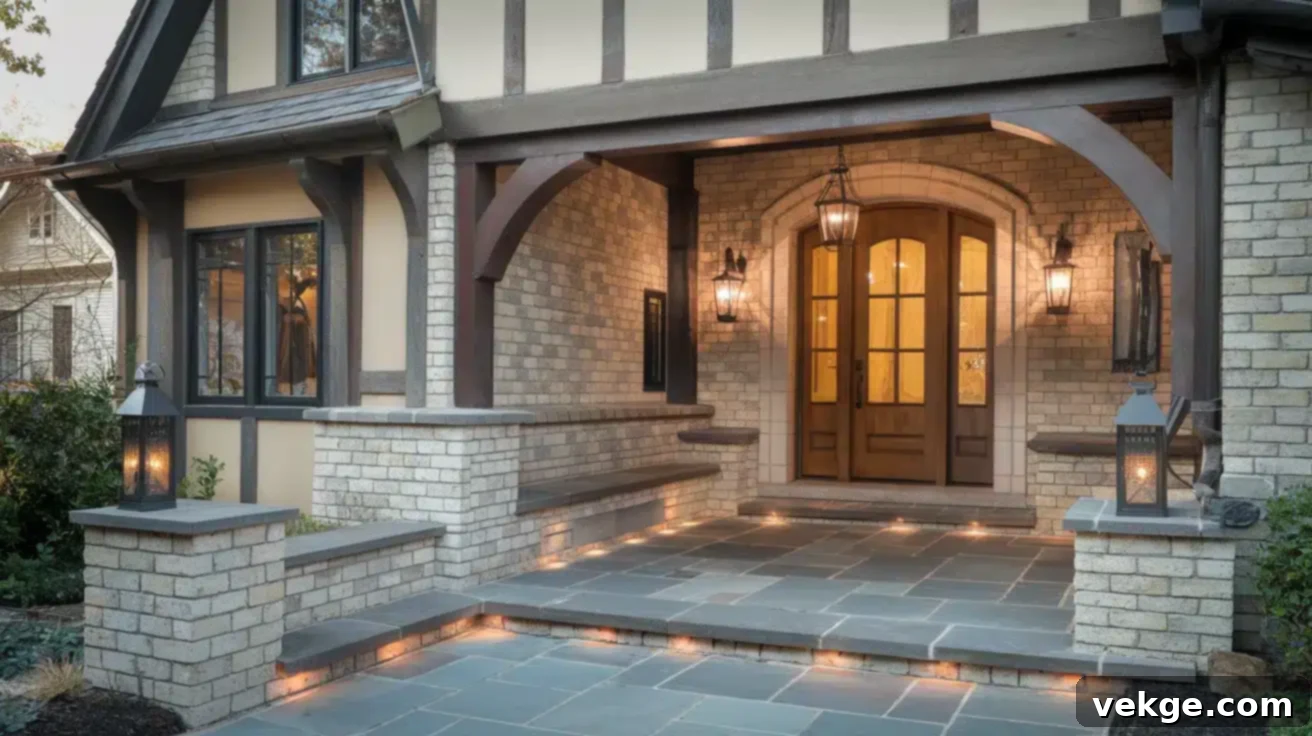
This Tudor home achieved a more grand and welcoming entrance through the addition of a thoughtfully designed and seamlessly integrated entryway extension. The original small stoop was replaced with a properly covered, expansive entry, which not only offers welcome protection for guests from the elements but also significantly enhances the home’s architectural interest and scale.
The new porch was meticulously crafted to perfectly match the existing home’s style and materials, giving the impression that it had always been an integral part of the original design. This extension elevated the entire facade, adding both functionality and a profound sense of grandeur.
- Robust timber framing expertly matched to existing architectural details, ensuring visual continuity and structural integrity.
- A durable flagstone floor, potentially enhanced with discreet heating elements for comfort during colder months.
- Custom lanterns, handcrafted by a local blacksmith, providing unique, period-appropriate illumination and artistic flair.
- A built-in bench, offering a convenient spot for package placement or a momentary rest, blending practicality with aesthetics.
11. Comprehensive Exterior Overhaul
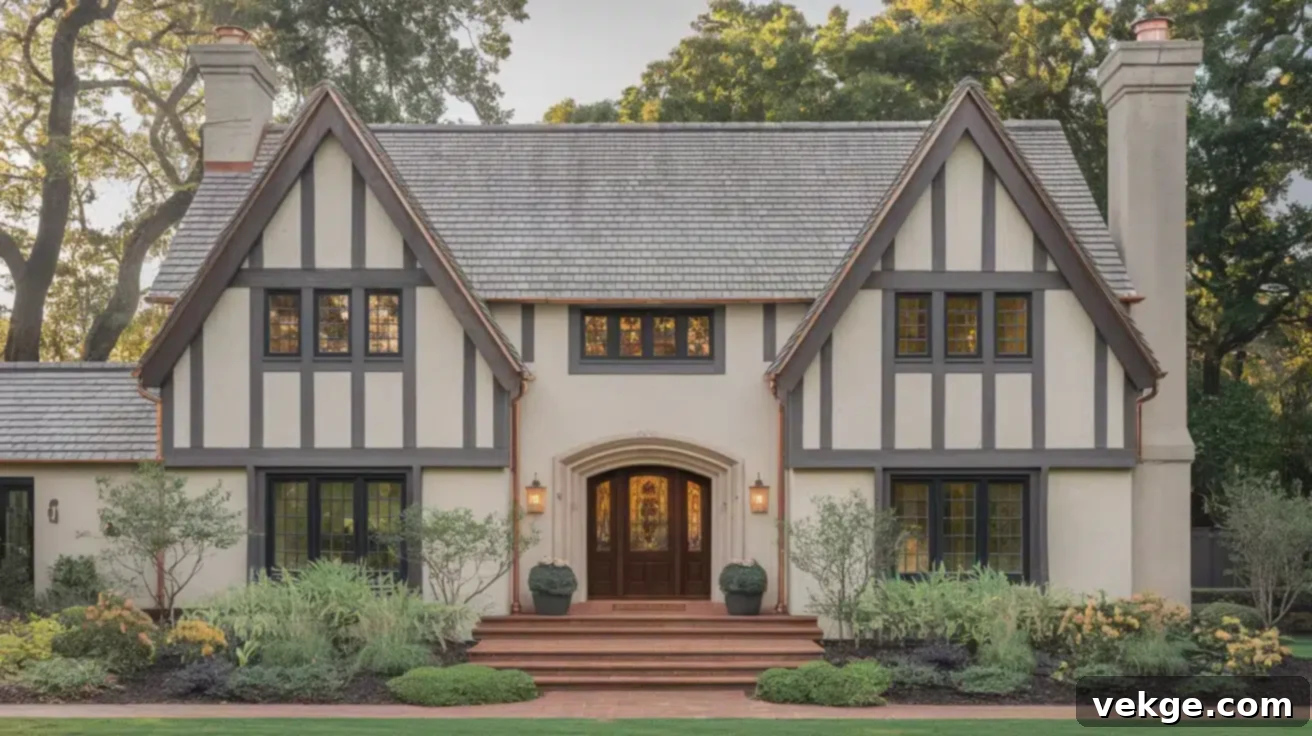
Sometimes, a vision calls for a truly comprehensive approach. This total exterior transformation touched every single element while profoundly respecting the Tudor home’s underlying architectural “bones.” The owners embarked on a complete renovation, replacing the siding, all windows, doors, and the roof. They also added elegant copper gutters, installed new, architecturally appropriate chimneys, and entirely redid the landscaping.
Crucially, every change was executed with a keen understanding of Tudor aesthetics, ensuring that the classic shape and feel of the home were not only preserved but enhanced. The result is a meticulously restored and upgraded Tudor that honors its past while offering modern performance and curb appeal, proving that even a complete overhaul can be executed with historical sensitivity.
- New stucco applied with the proper texture and a carefully selected, historically accurate color.
- A hand-split cedar shake roof, providing a natural, enduring, and visually rich topping for the home.
- Custom-designed doors and windows installed throughout, ensuring a perfect fit and cohesive style.
- Elegant copper gutters and downspouts, which will develop a beautiful patina over time, adding a touch of luxury.
- Professional landscaping featuring mature plants, thoughtfully designed to complement the home’s grandeur from day one.
Essential Features of Tudor Architecture: Understanding the Classic Style
When I observe Tudor homes, their distinctive and unique appearance always stands out, a style that proudly dates back hundreds of years. You can easily identify these charming residences once you know what specific architectural elements to look for. Understanding these core features is key to appreciating and authentically renovating a Tudor home.
1. Exposed Wooden Beams (Half-Timbering)
Perhaps the most iconic and eye-catching feature of Tudor homes is the visible wooden framework, known as “half-timbering,” that you can see from the outside. These dark, often richly stained wooden lines create striking geometric patterns against lighter-colored stucco or plaster infill panels. Far from being merely decorative in their origin, these beams were once structural, holding the entire house up. Today, while often ornamental, they remain the signature design element that gives Tudor homes their universally recognized and special pattern.
2. Steep, Pitched Roofs with Multiple Gables
Look up at any Tudor home, and you’ll immediately notice roofs that rise at dramatically sharp angles and often boast multiple sections pointing in different directions. These steeply pitched roofs were originally engineered in England to efficiently shed heavy snow and rain. The complex interplay of various gables (triangular portions of the wall between the edges of a sloping roof) creates an interesting, dynamic silhouette against the sky, adding to the home’s distinctive, storybook charm.
3. Tall, Narrow Windows with Divided Lights
Tudor windows are typically characterized by their tall and narrow proportions. Many feature small, individual glass panes held together by slender metal or lead strips, creating a “divided light” pattern. These casement windows (windows that open outwards on hinges) allow light to filter in, often casting beautiful patterns on the interior walls. While letting in ample light, they maintain the home’s historic and often fortress-like feel, contributing to its authentic period charm.
4. Arched Doorways with Robust Brick or Stone Details
Approaching a Tudor home, you’ll frequently find yourself walking through a charming arched doorway that evokes the sense of entering a mini-castle. The walls surrounding these entrances are often constructed from sturdy brick or natural stone, sometimes laid in intricate patterns or featuring decorative carvings. These solid, heavy materials provide a beautiful counterpoint to the more delicate wooden elements of the half-timbering, emphasizing durability and a welcoming, protective threshold.
5. Earth-Tone Color Palettes
Tudor homes traditionally utilize a palette of colors inspired directly by nature. These include:
- Rich browns, reminiscent of fertile soil and natural timber.
- Lush greens, echoing forest leaves and natural foliage.
- Warm reds, similar to clay tiles and bricks.
- Soft creams or off-whites, evocative of natural limestone or plaster.
These organic colors help the house blend harmoniously with its natural surroundings and provide the perfect backdrop, allowing the dark wooden beams to truly pop and define the architectural style. Understanding these five key components will not only enable you to easily spot Tudor homes anywhere but might also spark wonderful ideas for enhancing your own cherished residence!
Top Tips for Timeless Tudor Exterior Improvements
Having witnessed countless Tudor homes gain a new lease on life through thoughtful and strategic changes, I can assure you that revitalizing your home doesn’t require an exorbitant budget. With the right approach, your Tudor can shine again, blending historical accuracy with modern appeal. Here are my top five proven tips for effective Tudor exterior improvements:
1. Refresh and Harmonize the Paint
The correct color choices can make an extraordinary difference in enhancing a Tudor home’s curb appeal. I consistently recommend selecting historically appropriate shades that stand the test of time rather than fleeting trends. Consider these timeless combinations:
- **For the wooden beams:** Opt for a deep, rich dark brown or a classic, crisp black to provide striking contrast and definition.
- **For the wall infill (stucco/plaster):** Choose elegant cream, soft white, or a light tan to brighten the facade and make the timbers stand out.
- **For doors and shutters:** Introduce subtle accents with soft greens, muted reds, or deep blues to add character without overwhelming the primary scheme.
Always avoid trendy colors that might quickly look dated. Instead, select shades that would feel perfectly at home in old England. This single, impactful change can instantly elevate the entire appearance of your house, providing a refreshed and polished look.
2. Thoughtfully Upgrade Windows and Doors
Old, single-pane windows are notorious for letting in cold air, leading to higher energy bills. The good news is that modern manufacturers offer energy-efficient windows that perfectly mimic the traditional appearance of old Tudor windows! You can find new windows with authentic divided light patterns—the thin strips between glass panes that Tudor homes are known for—ensuring your house stays warm and your bills stay low, all while preserving the correct aesthetic.
The same principle applies to doors. A new, solid wood door, perhaps with an arched top and period-correct hardware (like wrought iron or heavy brass), can dramatically transform the entrance and overall impression of your home, making it more welcoming and secure.
3. Enhance and Structure Your Landscaping
Plants and landscaping are not just for beauty; they frame your home, drawing attention to its architectural strengths and creating an inviting atmosphere. Strategic landscaping can significantly boost your Tudor’s curb appeal. Try integrating these elements:
- **Low-lying bushes:** Plant evergreen hedges or boxwoods along the base of the house to create a neat, structured foundation.
- **Climbing plants:** Utilize trellises for elegant climbing roses or ivy, adding vertical interest (but avoid letting them directly climb onto the delicate wooden beams, which can cause damage).
- **Period-appropriate flower beds:** Choose plants and flowers that would have been common during the Tudor era or that complement the home’s historic palette.
- **Curved stone paths:** Design gently curving stone or brick pathways that lead gracefully to your front door, adding visual interest and guiding visitors.
Even simple additions like fresh mulch around your plants can make everything look tidier, more deliberate, and beautifully put-together.
4. Improve Exterior Lighting for Ambiance and Safety
When the sun sets, well-designed exterior lighting can magically transform your Tudor home, highlighting its unique features and creating an enchanting ambiance. I particularly appreciate how the right lighting can dramatically showcase those distinctive wooden beams at night!
When selecting lighting, look for fixtures that are both functional and aesthetically aligned with Tudor style:
- **Wall-mounted lights:** Choose fixtures that resemble old-world lanterns, ideally in materials like copper or wrought iron, placed strategically at entrances and along the facade.
- **Soft path lights:** Install low-level, warm-toned lights to safely guide guests along pathways to your door, enhancing both safety and visual appeal.
- **Architectural spotlights:** Position subtle spotlights aimed upwards to emphasize the steep rooflines, gables, and textured stone or brickwork.
Modern lighting solutions are relatively easy to install and significantly enhance both the beauty and security of your home after dark, creating an inviting and safe environment.
5. Prioritize Roof and Masonry Maintenance
The roof and the brick or stone walls are foundational elements that ensure your Tudor home stands strong and proud for generations. Regular, proactive maintenance of these critical components is paramount. Make it a habit to check them annually for any signs of wear or damage:
- **Roof integrity:** Inspect for missing, cracked, or broken roof tiles or shakes, as these can lead to water ingress.
- **Masonry condition:** Look for any cracked, crumbling, or deteriorating mortar between bricks or stones, which will require repointing.
- **Water damage indicators:** Be vigilant for any unexplained water stains, discoloration, or signs of dampness on walls or ceilings, which could indicate deeper issues.
Addressing small problems promptly before they escalate into larger, more costly repairs will save you significant money and effort in the long run. Consistent maintenance ensures your Tudor continues to look its best, preserving its character and value for many years to come.
Conclusion: Crafting the Next Chapter for Your Tudor Home
I genuinely hope these compelling before-and-after examples have vividly demonstrated how both subtle touches and more significant updates can collectively unlock and amplify the inherent beauty of your Tudor home. Every thoughtful change, from a refreshing coat of paint and enhanced lighting to energy-efficient new windows and meticulously repaired brickwork, contributes meaningfully to your home’s aesthetic appeal and its long-term value.
The most encouraging aspect of these renovations is that you don’t have to tackle everything at once. You can approach these projects incrementally, prioritizing what bothers you most, what aligns with your current budget, or what will yield the greatest immediate impact. This phased approach makes the renovation process manageable and enjoyable.
Your Tudor home carries a rich history, a story that spans hundreds of years. By making thoughtful, historically sensitive, yet modern enhancements, you are actively helping to write its next beautiful chapter, ensuring its legacy continues for future generations.
Which Tudor makeover has most caught your eye, or what specific detail inspired you the most? We’d love for you to share your favorite look or perhaps even your own home’s transformation journey in the comments section below. I’m always keen to see what moves you and sparks your creativity!
Frequently Asked Questions About Tudor Home Renovations
How Much Does It Cost to Renovate a Tudor Home Exterior?
The cost to renovate a Tudor home exterior can vary widely based on the scope and complexity of the project. Most Tudor exterior renovations typically range between $15,000 to $40,000. Simple paint refresh projects might start around $5,000, while comprehensive transformations involving multiple elements like roofing, windows, and masonry can easily reach higher ranges, often exceeding $70,000 or more for a complete overhaul.
Can I Add Tudor Elements to a Non-Tudor Home?
Yes, it is possible to incorporate Tudor-inspired features to give a non-Tudor home a touch of this classic style. Popular additions include decorative half-timbering on gables or accent walls, installing an arched entryway with stone or brick surrounds, or updating windows to feature leaded glass or divided light patterns. However, it’s crucial to ensure these additions blend harmoniously with the existing architecture to avoid a disjointed look.
How Do I Choose the Right Contractor for My Tudor Home Renovation?
Selecting the right contractor is paramount, especially for historic or architecturally distinctive homes like Tudors. Look for contractors with specific, proven experience in historic or Tudor-style home renovations. Always ask for a portfolio of similar projects they have completed, thoroughly check their references, and verify their licensing and insurance. Crucially, ensure they demonstrate a deep understanding of proper techniques for working with traditional materials and respecting the unique character of Tudor architecture.
